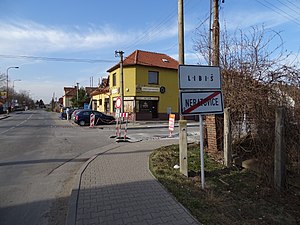Obec

Obec(Czech pronunciation:[ˈobɛts],plural:obce) is theCzechandSlovakword for amunicipality(in theCzech Republic,inSlovakiaand abroad). The literal meaning of the word is "commune"or"community".It is the smallest administrative unit that is governed by elected representatives. Cities and towns are also municipalities.
Definition[edit]
The legal definition (according to the Czechcode of law[1]with similar definition in the Slovak code of law[2]) is:"The municipality is a basic territorial self-governing community of citizens; it forms a territorial unit, which is defined by the boundary of the municipality."
Every municipality is composed of one or morecadastralareas. Every municipality is also composed of one or more administrative parts, usually called town parts or villages. A municipality can have its own flag and coat of arms.[1][2]
Czech Republic[edit]
Almost the entire area of the Czech Republic is divided into municipalities, with the only exception beingmilitary training areas.The smaller municipalities consist only of one village. A municipality usually has the same name as its most populated settlement, which usually contains the municipal office. However there are several exceptions, for example municipalities created by mergers of formerly separate municipalities (such asBrandýs nad Labem-Stará BoleslavorOrlické Podhůří).
A municipality can obtain the title of acity(statutární město),town(město) ormarket town(městys). While all of these are municipalities from the point of view of the law, they are usually referred to by their titles and not as municipalities. Municipalities without any other status are just called municipalities. Statutory cities can have self-governing subdivisions, so-called city parts or city districts (městská část), which are somewhat similar to municipalities in that they have their own town halls and local government.[1]Town and market town are above all ceremonial labels bestowed on municipalities with notable population, history and regional significance.[citation needed]
A special type of municipality is the capitalPrague,which has simultaneously the status of a municipality and aregion,and which is treated by special law.[3]
The law makes it possible for municipalities which were stripped of town status during the Communist period to retain that status automatically. For any other municipality to gain town status, it must have population over 3,000 and must pass an assessment by the chairman of the parliament. For market town status, population is not a condition.[1]The newest Czech town isChýně,which obtained the status in 2023.[4]
Some municipalities haveextended competenciesofdelegated state administrationfor the territory of the municipality and for surrounding municipalities.[5]
Statistics[edit]
| Total | Cities | Towns | Market towns | Other municipalities | |
|---|---|---|---|---|---|
| Over 99,999 | 6 | 6 | – | – | – |
| 50,000–99,999 | 13 | 13 | – | – | – |
| 25,000–49,999 | 21 | 8 | 13 | – | – |
| 10,000–24,999 | 91 | – | 91 | – | – |
| 5,000–9,999 | 148 | – | 144 | – | 4 |
| 2,500–4,999 | 280 | – | 177 | 8 | 95 |
| 1,000–2,499 | 963 | – | 127 | 114 | 722 |
| 500–999 | 1,382 | – | 18 | 86 | 1,278 |
| Under 500 | 3,350 | – | 13 | 24 | 3,313 |
| Total | 6,254 | 27 | 583 | 232 | 5,412 |
| Total | Cities | Towns | Market towns | Other municipalities | |
|---|---|---|---|---|---|
| Average | 1,731 | 135,177 | 6,404 | 1,186 | 577 |
| Median | 452 | 63,856 | 4,154 | 1,025 | 380 |
| Minimum | 16 | 34,306 (Třinec) | 79 (Přebuz) | 160 (Levín) | 16 (Vysoká Lhota) |
| Maximum | 1,357,326 | 1,357,326 (Prague) | 37,262 (Česká Lípa) | 4,294 (Nehvizdy) | 5,291 (Bystřice) |
| Total | 10,827,529 | 3,694,895 | 3,733,466 | 274,007 | 3,125,161 |
The smallest municipalities by area areZávist(0.42 km2) andStrukov(0.53 km2).[7]The biggest are the cities ofPrague(496.21 km2),Brno(230.18 km2) andOstrava(214.23 km2), and the town ofRalsko(170.23 km2,including a former military area, with only about 2,000 inhabitants).[8]
List of municipalities[edit]
Slovakia[edit]
As of 2020, there are2,890 municipalitiesin Slovakia, with 141 of thembeing a city or a town.[9]
After meeting certain conditions such as population over 5,000, being well accessible, having cultural or economical significance and having an urban style of settlement, a municipality can be declared a town (mesto).[2]
References[edit]
- ^abcd"Zákon č. 128/2000 Sb. o obcích (obecní zřízení)".zakonyprolidi.cz(in Czech).Retrieved17 September2020.
- ^abc"Úplné znenie č. 612/2002 Z. z."zakonypreludi.sk(in Slovak).Retrieved17 September2020.
- ^"Zákon č. 131/2000 Sb. o hlavním městě Praze".zakonyprolidi.cz(in Czech).Retrieved17 September2020.
- ^"Středočeská Chýně se stala městem. Navíc chystá oslavy 750 let"(in Czech). Náš region. 17 May 2023.Retrieved21 May2023.
- ^"Zákon č. 314/2002 Sb. o stanovení obcí s pověřeným obecním úřadem".zakonyprolidi.cz(in Czech).Retrieved17 September2020.
- ^ab"Population of Municipalities – 1 January 2023".Czech Statistical Office.23 May 2023.
- ^"Základní tendence demografického, sociálního a ekonomického vývoje Olomouckého kraje".Czech Statistical Office.p. 10.Retrieved9 May2022.
- ^"All about territory".Public database.Czech Statistical Office.Retrieved9 May2022.
- ^"Slovenská republika – sumárne údaje".sodbtn.sk(in Slovak).Retrieved17 September2020.
